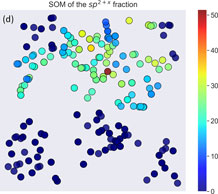Published online by Cambridge University Press: 24 April 2019

Unlike other data intensive domains, understanding distributions, trends, correlations, and relationships in materials data sets typically involves navigating high-dimensional spaces with only a limited number of observations. Under these conditions extracting structure/property relationships is not straightforward and considerable attention must be given to the reduction of feature space before predictions can be made. Here we have used Kohonen networks (self-organizing maps) to identify hidden structure/property relationships in computational sets of twinned and single-crystal diamond nanoparticles based on structural similarity in multiple dimensions, and confirmed the importance of a limited number of surface chemical features using regression.